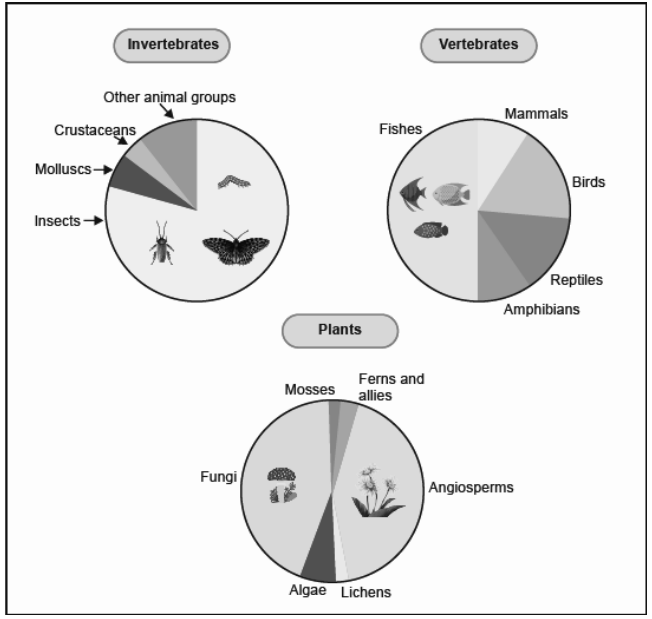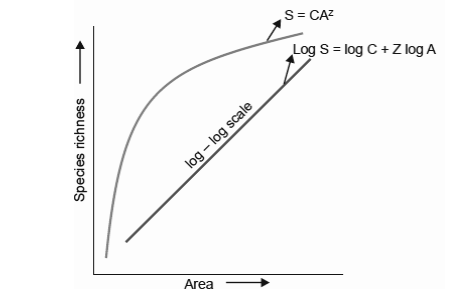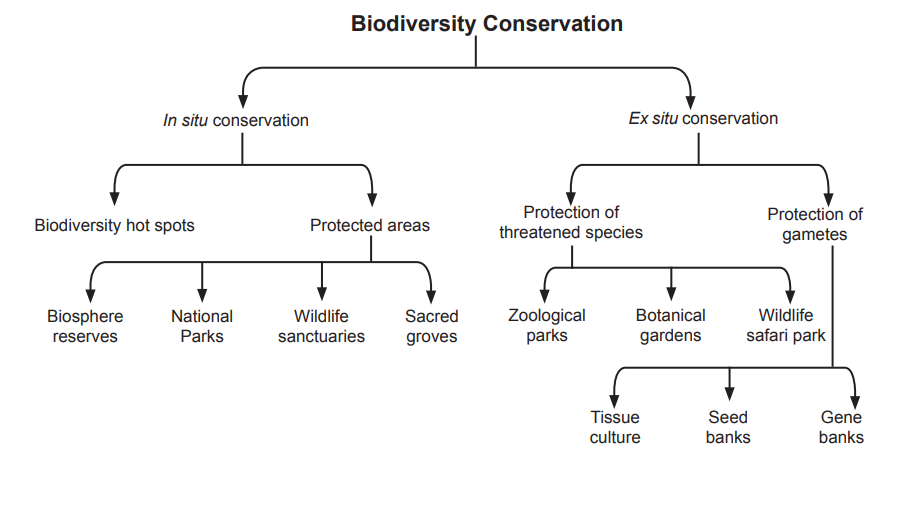All about Biodiversity & Conservation in Biology
- Other Laws|Blog|
- 8 Min Read
- By Taxmann
- |
- Last Updated on 22 September, 2022

2.1 Latitude and Altitude Gradients
6. Conservation of Biodiversity
7. How to Conserve Biodiversity?
Checkout Tan Print’s Biology for NTA CUET (UG) 2022 intends to cater to the principal needs of all the students preparing for the Common University Entrance Test (CUET) at the Undergraduate Level in the Biology Domain. This book features a brief coherent introduction of all the topics, supported by various exercises plus multiple-choice questions (MCQs) to prepare for the examination.
1. A Quick Review
-
- Biodiversity (synonym for ‘life on earth’) or biological diversity (GK bios life, Diversity forms) is the occurrence of different types of ecosystem, different species of organisms with their biotypes and genes adapted to different climates, environments along with their interactions and processes.
- The term ‘biodiversity’ was given by Edward Wilson.
- Biodiversity includes three interrelated hierarchial levels. These are – genetic diversity; species diversity; and community or ecosystem diversity.
- Genetic diversity means variation of genes within the species; the differences could be in alleles (different variants of same genes), in entire genes (the traits determining particular characteristics) or in chromosomal structures.
- The genetic diversity enables a population to adapt to its environment and to respond to natural selection.
- The amount of genetic variation is the basis of speciation (evolution of new species). It plays an important role in the maintenance of diversity at species and community levels.
- Genetic diversity is the basis of formation of new species. The greater is the genetic diversity of a species, the higher is its efficiency to adapt. The greater the diversity the wider is the geographical distribution.
- For example, medicinal plant Rauwolfia vomitoria growing in Himalayan ranges shows variation in potency and concentration of the active chemical reserpine that it produces.
- The variety in the number and richness of the species of a region is known as species diversity.
- The number of species per unit area is called species richness and the number of individuals of different species represents species evenness.
- For example, the Western Ghats have a greater amphibian species diversity than the Eastern Ghats.
- Ecological diversity it is a measure of the diversity at community and ecosystem levels. They represent the local, unique habitat and regional components of species diversity.
- For example, ecological diversity is greater in India than a Scandavian country like Norway due to presence of large number of ecosystems like deserts, rainforests, coral reefs, wetlands, estuaries and alpine meadows.
1.1 Global Species Diversity
-
- According to the International Union for Conservation of Nature and natural resources or IUCN (2004), the total number of plant and animal species is over 1.5 million.
- A more conservative and scientifically sound estimate made by Robert May, places the global species diversity at about 7 million.
- More than 70 per cent of all the species are animals, while plants account for about 22 per cent of the total.
- Amongst animals, insects comprise more than 70 per cent that means, out of every 10 animals on this planet, 7 are insects on this earth.
- India has only 2.4 per cent of world’s land area and 8.1 per cent global species diversity. There are nearly 45,000 plants and twice as many animals. So, India is one of 12 megadiversity countries of the world.
- Large number of species are facing threat of becoming extinct even before we discover them.
- We cannot estimate diversity of prokaryotes because conventional taxonomic methods are not suitable for identifying microbial species and many species are simply not culturable under laboratory conditions. If we accept biochemical or molecular criteria for delineating species of prokaryotes, then their diversity might run into millions

2. Gradient of Biodiversity
2.1 Latitude and Altitude Gradients
-
- Species diversity decreases as we move away from the equator towards the poles.
- It reaches the maximum in tropical rain forests. Tropics account for greater biological diversity.
- Maximum diversity occurs in Amazon rain forest of South America.
- Reasons behind the maximum biological diversity in tropical regions are:
-
-
- Prolong evolutionary time: Speciation is generally a function of time, unlike temperate regions subjected to frequent glaciations in the past, tropical latitudes have remained relatively undisturbed for millions of years and thus, had a long evolutionary time for species diversification.
- Constant environment: Tropical environments, unlike temperate ones, are less seasonal, relatively more constant and predictable. Such constant environments promote niche specialization and lead to a greater species diversity.
- High productivity: There is more solar energy available in the tropics, which contributes to higher productivity; this in turn, might contribute indirectly to greater diversity.
-
2.2 Species–area relationship
-
- German naturalist and geographer Alexander von Humboldt observed that within a region, species richness increased with increasing explored area but up to a limit.
- The relationship between species richness and area is a rectangular hyperbola for a wide variety of taxa whether they are birds, bats, fresh water fishes or flowering plants.

-
- On a logarithmic scale, the relationship is a straight line described by the following equation: log S = log C + Z log A
Where S = Species richness A = Area
Z = Slope of the line (regression coefficient) C = Y-intercept. - The value of Z lies in the range of 0.1–0.2 regardless of taxonomic group or the region. Whether it is plants in Britain, birds in California or molluscs in New York State, slopes of regression are similar.
- However, the analysis in a very large area like the whole continent gives a Z value that ranges from 0.6 to 1.2. For example, for frugivorous (fruit eating) birds and mammals in the tropical forest of different continents, the slope is 1.15.
- On a logarithmic scale, the relationship is a straight line described by the following equation: log S = log C + Z log A
3. Importance of Biodiversity
-
- Biodiversity is essential for stability of an ecosystem.
- Characteristics of a stable community:
-
-
- Productivity should not vary too much from year-to-year.
- It should be resistant to occasional natural and man-made disturbances.
- It should be resistant to invasions by alien species.
-
-
- Importance of species diversity to ecosystem can be explained by:
-
-
- Productivity-stability hypothesis: David Tilman found that areas with more species showed less year-to-year variation in total biomass. He experimentally showed that, increased diversity contributed to higher productivity.
- Diversity-stability hypothesis: According to Johnson et al 1996, the ecological communities will decrease in ability to recover from disturbance and in productivity if there is reduction in species richness.
- Rivet popper hypothesis: According to this hypothesis proposed by Stanford ecologist Paul Ehrlich (1981), the relationship between species richness and ecosystem functioning is non-linear, but may follow a variety of possible trajectories. The loss of a few species (or rivets holding together an aeroplane) will initially create no problem, but beyond a certain point loss will cause catastrophic effect.
-
4. Loss of Biodiversity
-
- The most serious aspect of the loss of biodiversity is the extinction of species.
- Extinction is of three types – natural extinction, mass extinction and anthropogenic extinction.
- Natural or background extinction is a slow process of replacement of existing species with the better adapted species due to alternate evolution, changes in environmental conditions, predators and diseases.
- Earth has experienced five mass extinctions due to environmental catastrophes. Mass extinction is a catastrophic, widespread– often global–event in which major groups of species are wiped out over a relatively short period.
- Anthropogenic extinctions are extinctions abetted by human activities like settlements, hunting, over exploitation and habitat destruction.
- Some recently extinct species are dodo (Mauritius), quagga (Africa), thylacine (Australia), Stellar’s sea cow (Russia) and three tiger species (Bali, Java, Caspian).
- Red Data Book and IUCN
- IUCN is International Union of Conservation of Nature and Natural Resources which is now called World Conservation Union (WCU). It maintains a red data book or red list which is a catalogue of tax a facing risk of extinction.
5. Red List Categories
| Extinct : | The tax on has been completely eliminated or died out from earth, e.g., Dodo |
| Critically Endangered : | The tax on is facing very high risk of extinction in the wild and can become extinct any moment in the immediate future e.g. Pigmy Hog. |
| Vulnerable : | Presently the population is sufficient but is undergoing depletion due to some factor or factors so that it is facing risk of extinction in medium term future, e.g., Clouded leopard |
| Extinct in wild : | The tax on is absent in any of its natural or expected habitats in the wild. |
| Endangered : | It is facing a high risk of extinction in the wild in the near future due to decrease in its habitat, excessive predation or poaching, e.g., Lion Tailed Macaque. |
| Lower risk : | They are threatened species which have lower risk of extinction and therefore, require only a small attention to become normal flourishing species. |
| Data deficient : | The data for making direct or indirect assessment of risk of extinction is deficient. |
| Rare species : | They are species with naturally small populations, either localised or thinly scattered, which are always at risk from pests/pathogens/predators/exotic species. |
| Not evaluated : | The tax on has not been evaluated for risk of extinction. |
| Indeterminate species : | The species are in danger of extinction but the reason is not known |
-
- Loss of biodiversity in a region may lead to
-
-
- decrease in plant production.
- less resistance to environmental disturbances such as drought.
- increased variability in ecosystem processes like plant productivity, water use, pest and disease cycles.
-
-
- Causes of Biodiversity Loss
-
-
- Four major causes (Evil Quartet)
- Habitat loss and fragmentation: Due to destruction of natural habitat, burning of forests, cutting down trees, forcing animals out of their habitats, which in alien lands die out after sometime.
- Over-exploitation: Increasing human population has escalated the use of natural resources. Many animals have become extinct in the last 500 years due to over exploitation by humans.
- Alien Species Invasions: Non-native or alien species often become invasive and drive away the local species. It is the second major cause of extinction. E.g., Water hyacinth (Eichhornia crassipes) was introduced in Indian waters to reduce pollution. It has clogged water bodies including wetlands at many places resulting in death of several aquatic plants and animals.
- Co-extinction: Certain obligatory mutualistic relationships exist in nature, e.g., Pronuba yuccaselles (a Moth) and Yucca (Plant). Extinction of one will automatically cause extinction of the other. This is known as co-extinction.
-
6. Conservation of Biodiversity
-
- Conservation of biodiversity is protection uplift and scientific management of biodiversity so as to maintain it at its optimum level and derive sustainable benefits for the present as well as future strategies.
- There are three main reasons to conserve the biological diversity which can be grouped in three categories:
-
-
- Narrowly Utilitarian – useful human products like food, fibers, drugs and medicine, etc.
- Broadly Utilitarian – ecosystem services like provision of pollinators, climate regulation, flood and erosion control, ecological balance through nutrient cycling, etc.
- Ethical Utilitarian – every living species has an intrinsic value though it may not have any direct economic value, and also, every species has a right to live.
-

7. How to Conserve Biodiversity?
| In-situ conservation | Hotspots | Protected areas |
| In situ (on-site) is conservation and protection of the whole ecosystem and its biodiversity at all levels in order to protect the threatened species. Two methods are being used to save biodiversity, hotspots and protected areas. | Biodiversity hotspots are the areas characterized by very high levels of species richness, high degree of endemism and also accelerated habitat loss. Ecologically hotspots are determined by four factors as: number of species/species diversity; degree of endemism; degree of threat to habitat due to its degradation and fragmentation; degree of exploitation. | National parks are large areas meant for the protection of flora and fauna and are maintained for scientific, educational and recreational use. They are not usually used for commercial extraction of resources.
Sanctuaries are tracts of land with or without lake where wild animals/fauna can take refuge without being hunted. Biosphere reserves are multipurpose protected areas which are meant for preserving genetic diversity in representative ecosystems of various natural biomes and unique biological communities. Sacred forests and lakes (= sacred groves) are forest patches around places of worship which are held in high esteem by tribal communities. E.g., Karnataka, Maharashtra, Rajasthan. Ramsar sites are wetlands which are considered to be of international importance. Ramsar Convention (1971) is an international treaty for the conservation and sustainable utilisation of wetlands. Ramsar convention works for (a) conservation and use of wetlands, (b) recognition of fundamental ecological functions of wetlands and their cultural, economic, scientific and recreational value. There are 26 Ramsar sites in India. Some of these are Ashtamudi wetland (Kerala), Sambhar lake, Rudrasagar lake, Chilika lake, Bhitakanika wetland (Odisha). Wetlands include marshes, lakes, coral reefs, etc. |
| Ex-situ conservation | Offsite collection | Gene banks |
| It is the conservation of threatened plants and animals outside their natural habitats. These include offsite collections and gene banks. | These are live collections of wild and domesticated species in botanical gardens, zoological parks, wildlife safari parks, arboreta, etc. | These are institutes that maintain stocks of viable seeds (seed banks), live growing plants (orchards), tissue culture and frozen germplasm (cryopreservation) with the whole range of genetic variability. |
Disclaimer: The content/information published on the website is only for general information of the user and shall not be construed as legal advice. While the Taxmann has exercised reasonable efforts to ensure the veracity of information/content published, Taxmann shall be under no liability in any manner whatsoever for incorrect information, if any.

Taxmann Publications has a dedicated in-house Research & Editorial Team. This team consists of a team of Chartered Accountants, Company Secretaries, and Lawyers. This team works under the guidance and supervision of editor-in-chief Mr Rakesh Bhargava.
The Research and Editorial Team is responsible for developing reliable and accurate content for the readers. The team follows the six-sigma approach to achieve the benchmark of zero error in its publications and research platforms. The team ensures that the following publication guidelines are thoroughly followed while developing the content:
- The statutory material is obtained only from the authorized and reliable sources
- All the latest developments in the judicial and legislative fields are covered
- Prepare the analytical write-ups on current, controversial, and important issues to help the readers to understand the concept and its implications
- Every content published by Taxmann is complete, accurate and lucid
- All evidence-based statements are supported with proper reference to Section, Circular No., Notification No. or citations
- The golden rules of grammar, style and consistency are thoroughly followed
- Font and size that’s easy to read and remain consistent across all imprint and digital publications are applied





